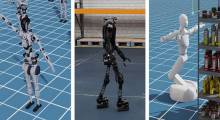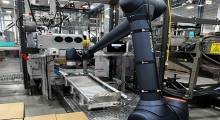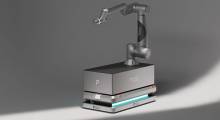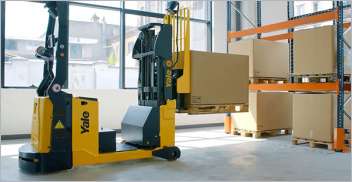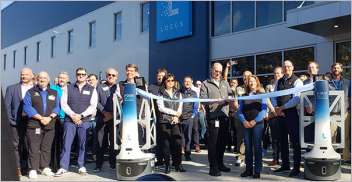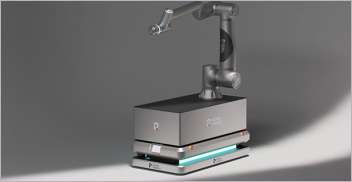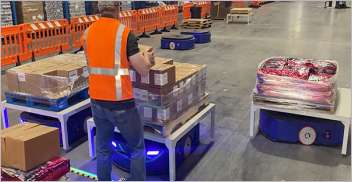With Halloween around the corner, you might soon see ghosts, monsters, and zombies rise from the grave to trick-or-treat at your doorstep. In the commercial robotics industry, one company also seems to have risen from the dead - although less like a zombie and more like a phoenix.
Founded in 2008, Rethink Robotics was known for its Baxter and Sawyer cobots. But these collaborative robots with human-like eyes aren’t coming back to haunt warehouses this Halloween. Rethink has relaunched, rebranded, and overhauled its robot portfolio to meet the needs of manufacturing and supply chain companies, learning from over a decade and a half of experience.
Relaunch and rebranding at IMTS 2024
Rethink Robotics was acquired by Germany-based HAHN Automation Group in 2018, and joined the United Robotics Group in 2021. The company recently debuted its new lineup of Reacher robot arms, Ryder autonomous mobile robots (AMRs) and the Riser mobile manipulation robot (MMR) at IMTS 2024.
Greg McEntyre, Rethink Robotics VP of operations, said the company’s new robots have been under development since HAHN took over.
“IMTS was the [right] timing to be able to bring our products back to the market and show everybody what we've been up to. So it was kind of purposeful to make it a surprise.”
Julia Astrid Riemenschneider, Rethink Robotics VP of business development, said in response to the shortcomings of its original robots, Rethink is relaunching with respect for past market perceptions.
“It was important to us that we also make a promise that we can keep,” she said. “Our promise - and maybe you saw that at the [IMTS] show - is ‘Better. Faster. Stronger.’ And that refers to the products, where we have a comprehensive portfolio, as well as to our own self commitment to that project.”
A breadth of new, robust robots for different applications
Chris Harbert, Rethink Robotics business development and sales consultant, said today’s company is trying to continue its original vision.
“Even though there were challenges with the original products' robustness, it was a company that most people wanted to see succeed,” he said. “The [cobot] market still seems underserved somehow. That's really what's behind Rethink - putting in those years of development work and wanting to come back and grow into a major player again, to help democratize accessibility to collaborative automation.
“Sawyer was a single-length, five-kilogram payload robotic arm,” Harbert added. “It just wasn't versatile enough to have a single offering. What the Rethink team has done with this new development and this new product line is to broadly expand the range of payloads and reaches that are available.”

McEntyre said IMTS attendees appreciated Rethink’s wide offering of different robots, as well as their robustness.
“A lot of people, historically, have used collaborative robots in non-collaborative ways,” he said. “[Rethink’s] arms have the ability to flip into an industrial mode so that you're not limited to the collaborative restrictions of speed and capacity.
“These arms are built a little bit more rigorously,” he added. “So there is the ability to have this as a dual-purpose robot. If it needs to be a fixed installation for a specific purpose with higher speeds and demands, we have that capacity.”
Pain points with historical cobot, MMR applications
Even at industrial speeds and capacities, robot arms are most useful if they are placed in the best locations within a facility to maximize efficiency.
“When collaborative robots first came on the scene, one of the unspoken promises was that you're not going to have monoliths of these caged robots taking up your floor space whether you're using them or not,” Harbert said. “But you look at most collaborative robots, and they're on a stand or a pedestal somewhere, and they don't ever move.
“All of those kinds of robots have led to basically the same outcome: lower footprint with the collaborative robots compared to the industrial - but still the same outcome,” he added.
MMRs are one option to overcome the limitations of immovable cobot arms. Riemenschneider said United Robotics Group already provides MMRs for laboratory automation. But customers have asked, “Why should I pay for an AMR that’s sitting in front of a machine while the manipulator is loading or tending this machine?”
Ryder AMR can relocate Reacher arms autonomously
Rethink Robotics lineup of cobot arms and AMRs can be combined to form a Riser mobile manipulation platform. Because the robots are designed to be combined, Ryder AMRs can also be used to relocate Reacher arms throughout a facility.
“It really comes to the benefit of the workflow where we drop the cobot, and the AMR can take off and take care of other jobs while the robot arm is charging plus taking care of its task,” Riemenschneider said. “If we look into the calculation of the ROI, that contributes and makes the solution much more affordable.”

“One AMR can do fleet management for multiple production cells,” McEntyre said.
Harbert added the robot arm and AMR portions of an MMR are usually bolted together and not easily separated.
“Using a mobile robot and a robotic arm series that can work together and also separate and do their own jobs and then come back together - that is a really new concept,” he said. “It's difficult to set up the same robot arm in front of the same machine 24/7, because pressure on manufacturers these days are smaller batches and more changeovers.
“It's impractical to have technicians unbolt an arm and move it by hand. It just doesn't work well. It's not realistic.” Harbert added. “Now you have a mobile robot that can deliver the robot arm from line two - where it was yesterday - to line six, where it needs to be today. And you don't have to do that manually. That can be schemed, that can be timed, that can be sequenced, and it's all done within that framework of your automation system.
“This is really a potential start to a new journey of applying collaborative robots in the manufacturing space in a much more end-user conscientious way,” he said.

The control box and power supply for each Reacher arm is independent, and not physically connected to the Ryder AMR. McEntyre said the AMRs can dock robot arm units with a precision of seven millimeters, or about a quarter of an inch. Once a Reacher is docked, it needs to recalibrate based on its new position.
“When it comes to the more finite machine tending, or needing to pick things up that are smaller, more accuracy is needed,” he said. “Putting a camera at the end of our tool will realign the robot arm no matter how far off it was, and we'll gain that performance back.”
Automated flexibility thanks to interchangeable EOAT
Interchangeable end-of-arm tooling (EOAT) has provided Rethink’s new robot arms with operational flexibility that was lacking with its original robots.
“Baxter and Sawyer had cameras embedded in the arms,” Harbert said. “There was an ease because it came with a camera. The challenge, of course, was that it wasn't always the right camera for what you wanted the robot to do.
“The original Rethink had their own grippers that they designed and fabricated,” he added. “That's fine for some applications, but there were limitations in terms of the connectivity with other equipment.
At IMTS, Rethink demonstrated EOAT interchangeability using OnRobot attachments.
“The versatility of using end-of-arm tooling that has some quick disconnect features… is you can have a self contained vacuum pickup, or you can have a gripper, so this can be flexible wherever it needs to be deployed,” McEntyre said.

Applications that can benefit from interchangeable EOAT include picking and packaging.
“Pick and pack is not usually a static workflow. You're not packing the same stuff into the same box every hour of every day,” Harbert said. “There's changeover of different products. There's different kits that might be going out. There's changes to box sizes. There's a lot of variability in that process flow.
“The versatility of connectivity allows you to have arms with certain cameras for kits that need can, or having certain types of grippers if you need to do palletizing, versus small item packing,” he added. “Having that connectivity right out of the box, you can put together your own Lego toolkit, essentially, of collaborative robots and whatever accessories you need.
“This new rethink portfolio has really addressed flexibility on a much broader scale - everything from connectivity, to the pairing of AMRs with collaborative robot arms, to thinking about, ‘How do you manage a holistic workflow?’” Harbert said.
“The spirit of Rethink that has continued - and still is in this new relaunching - is trying to solve real world problems, not just throw a robot at a process.”
Want to learn more about robots picking, packing and packaging? This article was featured in the October 2024 Robotics 24/7 Special Focus Issue titled “Robots picking and packing with precision.”
About the Author
Follow Robotics 24/7 on Linkedin
Article topics
Email Sign Up




